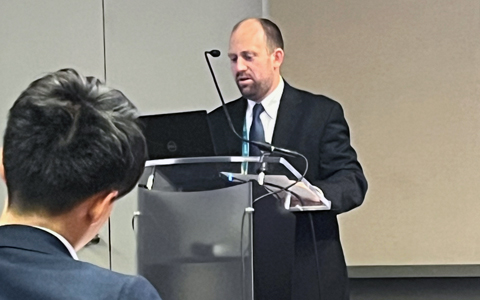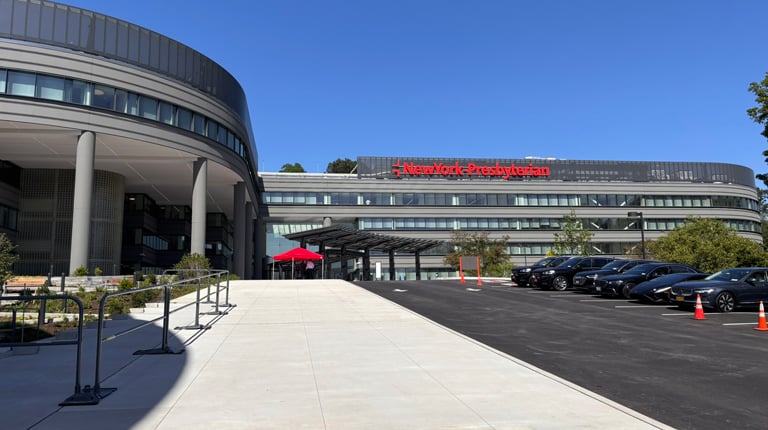
Mike Lowder, Director of Signal Engineering at VHB, is an industry leader in advanced signal design for urban transit networks. His vast signals experience and passion allow VHB’s Transit and Rail Signal Design Team, which he leads, to deliver safe, integrated, and future-focused signal systems. His experience includes the design, technical oversight, system integration, and overall project management of railway signaling train control systems. He has worked on many complex system implementation projects across the Chicago Transit Authority (CTA) system and, most recently, on the Red and Purple Line Modernization (RPM) Program for CTA, as well as the Massachusetts Bay Transportation Authority’s (MBTA) Red Line and Orange Line Signals Systems Upgrades Design-Build Project.
Joined by CTA and MBTA representatives, Mike recently moderated a panel discussion, “The Difficulties and Challenges of Implementing Next Generation Signal Systems and Products onto Legacy Transit Systems” at the American Public Transportation Association (APTA) Rail Conference in Pittsburgh.
We caught up with Mike after the conference to take a deeper dive into the signal technology challenges that agencies are facing and how to streamline the adoption of next generation train detection products.
VHB: First, can you tell us a little bit about new advancements in signal technology and how they are benefiting our railways?
Mike: New signal technologies and train detection systems, including Communications-Based Train Control (CBTC), digital track circuits, and the latest generation of audio frequency track circuits, provide many functions and features that benefit our rail systems. Modern rail signal technology uses advanced sensors and communication systems to improve the safety of passengers and train operators by detecting and preventing collisions, derailments, and other accidents. These systems allow trains to run more efficiently by reducing the spacing between trains and increasing the speed at which they can travel. It also helps to reduce travel time and delays, which improves overall service and enhances the passenger experience.
Modern rail signal technology is designed to be more reliable and require less maintenance (and maintenance cost) than older systems. Enhanced signal train detection systems also allow for more trains to run on the same track, which helps to increase capacity and reduce congestion.
Given all the advantages, opportunities, and benefits, transit agencies and their riders and operators stand to gain, there is a tremendous benefit to upgrading legacy signal systems. But the adoption of any new technology can involve growing pains. Commissioning modern signal technology on systems that were built many decades before these new technologies were available is extraordinarily challenging and few projects are completed on time, within budget, and without substantial unplanned impacts to rail operations. As we tackle the complexities of each project, we continue to learn and refine the implementation of this transformational technology and increase efficiency.
VHB: In your panel, you organized perspectives from several legacy projects. Can you share some insight from these projects and some of the challenges they faced?
Mike: I was joined by CTA representatives who discussed two major legacy projects, the first being Phase One of the Red and Purple Modernization (RPM) Program, which included full replacement of the signal system along a 5.5-mile stretch of a four-track railroad (22 track miles). The new track circuit was the first of its kind to be installed in the North American market, which presented many challenges from complex phasing to inexperienced teams. There was also a substantial amount of temporary work, which caused further staffing issues.
Similar challenges were experienced during CTA’s Jefferson Park to O’Hare Signals Project. This complex upgrade included the implementation of Double Rail, Audio Frequency Train Detection and Cab Signal System (AFTC5) and integrating the new track circuit product with established vital processor and communications network product lines. Because the new track circuit product was built from a European product line, experience with the new technology was limited locally. A lack of U.S. standards and unfamiliarity with European standards further complicated implementation. Detailed application design by the signal supplier added complexity due to the supplier’s unfamiliarity with CTA standard circuits. The learning curve was steep and had to be repeated as supplier staff moved on and off the project. As a result, the commissioning of each interlocking took three times longer than anticipated.
Together with MBTA representatives, we also discussed the challenges faced on the Red Line/Orange Line Signal Upgrade Design-Build Project in Boston. This project included the replacement of interlocking and track circuit equipment on two heavy rail rapid transit lines across 33 mainline miles with 26 signal locations and 833 track circuit modules. Existing system configuration and customized design preferences were not originally well defined; retroactively defining and adapting design within the contracting constraints of a Design-Build project proved one of the main challenges of this project. In addition, this technology was new to everyone involved—including the owner, the contractor, the designer, and the equipment supplier—which created a steep learning curve for all. Lastly, the testing and commissioning constraints were not considered during design of some of the complex interlockings to allow for a phased cutover, which meant the commissioning had to be all or nothing at many complex locations.
The lessons learned on these contracts were hard, but they will provide great value in informing many future projects. New signal technologies continue to be the next step for legacy signal systems across the country. Despite the difficulties they had to overcome, the CTA and the MBTA will realize their operational and safety goals with these projects and benefit for years to come. The systems will offer much more proactive diagnostics and information regarding the health of the track circuits so that issues can be fixed before the track circuit fails. These new systems also reduce the amount of trackside routine maintenance currently required for track circuits.
VHB: What would you consider to be the key points that attendees walked away with?
Mike: Signal modernizations are not straightforward upgrades in technology. When you modernize your signal system, even where it utilizes the same basic technology, there will be significant integration challenges. Agencies, designers, and contractors must recognize this and be prepared for iteration both in the design of and implementation of the system. In legacy systems, the system definition and design development need to follow a collaborative approach and the project schedule should properly account for this.
When proposing new technology, it’s worth the time and expense to develop a pilot with enough defined characteristics to account for the many configurations the technology will likely be implemented within. A pilot program allows the project team to work out the kinks of the new technology prior to the full implementation of the project.
Contractors also need to go into these projects recognizing their complexity to better assess the requirements to manage all aspects of the project integration. In addition, agencies need to clearly define all system/design constraints and requirements. The design inputs, assumptions, and criteria must be clearly defined, as well as the desired performance of the system after implementation.
The constraints of testing and commissioning can have a significant impact on the system architecture and design (as well as cost and schedule). Almost all signal system upgrades to legacy systems will require a phased commissioning plan to implement and are not as simple as just flipping a switch. Understanding and planning for this will be imperative to success.
Lastly, there isn’t enough appreciation for the support and maintenance needed after integration. Many times, maintenance procedures, tools, and training must change significantly. In some cases, operating rules and training need to be modified and the central control software and procedure may need to be adapted. This should be included in the project scope and recognized as a substantial portion of successful implementation.
VHB: In what ways do you find VHB at the forefront of helping agencies overcome these challenges?
Mike: By promoting open dialogue with our clients and at industry events such as APTA Rail, VHB aims to help agencies better understand integration challenges. Our goal is to help identify opportunities to standardize technical specifications across agencies, as well as reduce cost implications of customization and the inherent risks that come with customized systems.
VHB is collaborating with agencies such as the CTA and the MBTA to offer guidance on procurement strategies for new signal systems as well. This includes determining the ideal level of design and specifications, establishing procedures for reviewing and certifying new products or systems, and providing compliance with all safety and quality assurance requirements. Our intention is to help transit agencies and authorities make informed, smart decisions to build reliable and modern transit systems that support long-term and equitable investments in the communities they serve.
To learn how VHB can assist you on your next transit or rail project, visit our transportation page or connect with Mike Lowder via email or LinkedIn.



